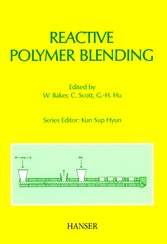Warren Baker, Chris Scott, Guo-Hua Hu
Reactive Polymer Blending
Foreword
8
Contents
10
Contributors
14
Preface
16
1 Introduction
18
1.1 Background
19
1.2 Important Blending Principles
20
1.3 A Historical Perspective on Reactive Blending
24
1.4 The Evolution of Commercial Practice
26
1.4.1 Patents and Products
26
1.4.2 Processing
27
1.5 Summary
28
References
28
2 Types of Reactive Polymers Used in Blending
30
2.1 Introduction
31
2.2 Compatibility in Polymer Blends
32
2.2.1 Basic Concepts
32
2.2.2 Strategies for Blend Compatibilization
32
2.3 Preparation of Reactive Polymers
34
2.4 Types of Compatibilizing Reactions
36
2.5 Types of Reactive Polymers and Their Applications
36
2.5.1 Reactive Polymers Having MAn Functionality
37
2.5.2 Reactive Polymers with Carboxylic Acid Functionality
39
2.5.3 Reactive Polymers Capable of Interchange Reactions
41
2.5.4 Reactive Polymers Containing Primary and Secondary Amines
43
2.5.5 Reactive Polymers Containing Hydroxyl Groups
43
2.5.6 Reactive Polymers Containing Heterocyclic Groups
46
2.5.7 Reactive Polymers Capable of Ionic Interactions
48
2.5.8 Miscellaneous Reactive Polymers
48
2.6 Concluding Remarks
49
List of Abbreviations
51
References
52
3 Reactive Blending with Immiscible Functional Polymers: Molecular, Morphological, and Interfacial Aspects
60
3.1 Introduction
61
3.2 Reactive Versus Physical Blending with Respect to Compatibilization
61
3.2.1 Similarities and Differences
61
3.2.2 Industrial Feasibility and Current Trends
63
3.3 In Situ Interfacial Chemical Reactions of Functional Polymers
64
3.3.1 Types of In Situ Chemical Reactions Involved
64
3.3.2 Kinetics of Interfacial Reactions and Molecular Characterization
66
3.4 Effects of Reactive Blending on Phase Morphology
70
3.4.1 Effect of Reactive Blending on Phase Morphology Generation
70
3.4.2 Effect of Reactive Blending on Phase Stabilisation in the Melt
80
3.4.3 Effect of Reactive Blending on Phase Co-Continuity
81
3.4.4 Interfacial Stability of the In Situ Formed Copolymer
84
3.5 Effect of Reactive Blending on Crystallization of Blends Containing Crystallizable Components
84
3.6 Blend Interface Characterization
86
3.6.1 General Aspects Concerning Polymer/Polymer Interfaces
86
3.6.2 Determination of the Interfacial Tension in Reactively Compatibilized Blends
89
3.6.3 Determination of the Interfacial Thickness in Reactive Blends
91
3.7 General Conclusions
95
References
96
4 Key Role of Structural Features of Compatibilizing Polymer Additives in Reactive Blending
99
4.1 Introduction
100
4.2 General Principles
102
4.3 Molecular Architecture of the Compatibilizer
102
4.3.1 Alternative 1
103
4.3.2 Alternative 2
103
4.3.3 Alternative 3
104
4.4 Phase Morphology Development
104
4.5 Effect of the Interfacial Reaction on the Phase Morphology Development
106
4.6 Effect of the Molecular Characteristic Features of the Reactive Polymers
107
4.6.1 Kinetics of the Interfacial Reaction
107
4.6.2 Molecular Weight of the Compatibilizer Precursors
112
4.6.3 Reactive Group Content of the Reacting Polymers
115
4.6.4 Distribution of the Reactive Groups Along the Chains
121
4.7 Effect of Processing Conditions
122
4.7.1 Melting Order of the Constitutive Components of Reactive Polyblends
122
4.7.2 Effect of Shearing
123
4.7.3 Initial State of Dispersion
124
4.7.4 Mixing Temperature
124
4.8 Conclusions
125
References
126
5 Morphological and Rheological Aspects of Reactive Polymer Blending
130
5.1 Morphology Development During Blending of Immiscible Polymers
131
5.1.1 The Melting Regime
133
5.1.2 The Melt Flow Regime
137
5.1.3 Final Morphology of Reactive Blends
144
5.1.4 Miscible Reactive Polymer Blends
149
5.2 Rheological Aspects of Reactive Polymer Blending
149
5.2.1 Rheological Changes During Blending
149
5.2.2 Rheology of Reactively Compatibilized Polymer Blends
151
5.3 Conclusions
155
5.4 Future Challenges
156
References
156
6 Reactive Blending in Screw Extruders
159
6.1 Introduction
160
6.2 Reactive Blending in Mixers
161
6.2.1 Copolymer Formation at Polymer/Polymer Interfaces
162
6.2.2 Batch Mixers for Reactive Blending
171
6.2.3 Reactive Blending in Screw Extruders
175
6.4 One-Step and Two-Step Reactive Blending Processes
187
6.4.1 PP/PA6 Blends
188
6.4.2 PP/PBT Blends
191
6.5 Concluding Remarks
194
References
195
7 Extrusion Equipment for Reactive Blending
197
7.1 Extruders Used for Reactive Blending
198
7.2 Mixing Mechanism
202
7.2.1 Distributive and Dispersive Mixing
203
7.2.2 Dissipative Melting
205
7.3 Residence Time and Residence Time Distribution
210
7.4 Devolatilization
211
7.5 Microstructure Development and Monitoring in Reactive Blending
214
7.6 Hybridized Polymer Processing Systems
218
7.7 Conclusions
221
References
222
8 Rubber Toughening of Polyamides by Reactive Blending
224
8.1 Introduction
225
8.2 Evolution of Polyamide Impact Modification Technology
229
8.3 Comparison of Reactivity vs. Toughening Efficiency of Various Functional Rubbers
233
8.4 Toughening Efficiency of Maleated EP Rubbers
241
8.4.1 Effect of Maleic Anhydride Content
241
8.4.2 Effect of Polyamide End Groups
243
8.5 Toughening Efficiency of Maleated Styrene-Ethylene/Butylene-Styrene (M-SEBS) Block Copolymer Rubbers
248
8.6 Effect of Mixtures of Reactive and Non-Reactive (Maleated and Unmaleated) Rubbers
253
8.7 Reactive Toughening of PA6 with Acyllactam-Grafted EP Rubbers
254
8.8 Toughening of Polyamides with Maleated LDPE
256
8.9 High Impact Polyamide/ABS Blend
258
8.10 Toughening Mechanisms in Rubber Modified Polyamides
260
8.10.1 Role of Rubber Particle Size on Polyamide Toughness
260
8.10.2 Role of Rubber Particle Cavitation on the PA Matrix Toughening
262
8.11 Rubber Toughening of Reinforced Polyamides
263
8.12 Applications of Rubber Toughened Polyamide
264
8.13 High Rubber/Polyamide Blends
265
8.14 Polyamide/Reactive Rubber Blending Process
267
8.16 Future Directions in Rubber Toughened Polyamides
268
References
269
9 Compatibilization Using Low Molecular Weight Reactive Additives
271
9.1 Introduction
272
9.2 Free Radical Reactivity and Compatibilization of Polyolefins
273
9.3 Polyethylene/Polystyrene Compatibilization
276
9.4 Compatibilization of Polyolefin/Polyamide Blends
280
9.5 Development of the Vector Fluid Compatibilization Concept
283
9.6 Special Peroxide
289
9.7 Inorganic Catalyst for PE/PS Compatibilization
290
9.8 A Recent Example
294
9.9 Summary
296
References
296
Index
298
© 2009-2024 ciando GmbH
 Zu Hanser-Fachbuch.de
Zu Hanser-Fachbuch.de
 Warenkorb
Warenkorb
